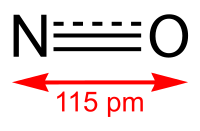
Photo from wikipedia
While the utility of reactive oxygen species in photodynamic therapies for both cancer treatments and antimicrobial applications has received much attention, the inherent potential of reactive nitrogen species (RNS) including… Click to show full abstract
While the utility of reactive oxygen species in photodynamic therapies for both cancer treatments and antimicrobial applications has received much attention, the inherent potential of reactive nitrogen species (RNS) including nitric oxide (NO˙) for these applications should not be overlooked. In recent years, NO˙ donor species with numerous-including photodynamic-mechanisms have been classified with efficacy in antimicrobial and therapeutic applications. While properties of NO˙ delivery may be tuned structurally, herein we describe for the first time a method by which photodynamic NO˙ release is amplified simply by utilizing a plasmonic metal substrate. This is a process we term "metal-enhanced nitric oxide release", or ME-NO˙. Using donor agents known as brominated carbon nanodots (BrCND), also the first carbon nanodot variation classified to release NO˙ photodynamically, and the fluorescence-on probe DAF-FM, we report metal-enhanced release of NO˙ 2- to 6-fold higher than what is achieved under classical conditions. Factors affecting the plasmon-amplified photodynamic system are subsequently studied, including exposure times, excitation powers, and surface area, and consistent ME-NO˙ factors are reported from BrCND across these tunable conditions. Only probe concentration is determined to impact the detected ME-NO˙ factor, with higher concentrations resulting in improved detectability of "actual" NO˙ release enhancement. Further, principles of metal-enhanced fluorescence (MEF) are applied to achieve a faster, high-throughput experimental method with improved data resolution in ME-NO˙ detection. The results have significant implications for the improvement of not just carbon nanodot NO˙ donor agents, but a wide spectrum of photoactivated NO˙ donor systems as well.
Journal Title: Nanoscale
Year Published: 2021
Link to full text (if available)
Share on Social Media: Sign Up to like & get
recommendations!